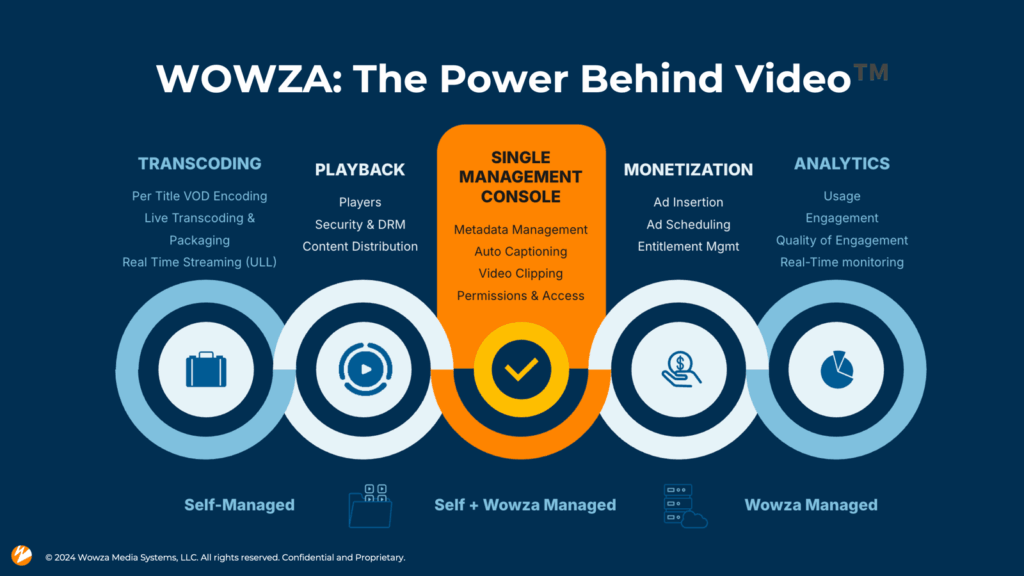Best Live Streaming Platforms – Everything You Need to Know
What is a Live Streaming Platform?
Live streaming platforms enable individuals and businesses to broadcast live video content over the internet in real time. From social media streams to professional-grade corporate events, these platforms provide the infrastructure, tools, and technology necessary to deliver seamless, high-quality, and low-latency video experiences to global audiences.
Table of contents
- What is a Live Streaming Platform?
- Introduction to Live Streaming Platforms
- Live Streaming Statistics – Why It’s Booming
- Live Streaming Technology Compatibility
- Live Video Streaming for Business – Maximizing ROI
- Professional Live Streaming Platforms – Features That Matter
- Comparing Live Streaming Platforms – Finding the Right Fit
- Frequently Asked Questions (FAQs)
- Conclusion
Introduction to Live Streaming Platforms
A live streaming platform enables individuals and businesses to broadcast live video content to an online audience in real time. Whether for gaming, marketing, corporate events, or entertainment, live streaming has become an essential tool for engagement, communication, and revenue generation.
In this guide, we’ll explore:
- What is a live streaming platform? Key features and how they work.
- Comparing the best platforms: Evaluating popular options, including why Wowza is the popular choice.
- Live streaming technology & low latency: Understanding low-latency video streaming and its benefits.
- Business & enterprise solutions: How live streaming is transforming industries and boosting engagement.
As live streaming continues to grow, choosing the right platform is crucial. Let’s dive in and find the best solution for your needs!
Defining Live Streaming Platforms
A live streaming platform is a service that allows users to capture, encode, transmit, and distribute live video over the internet. This differs from standard video hosting platforms that don’t facilitate real-time viewing.
Key Features of a Live Streaming Platform:
- Real-time video broadcasting with minimal delay.
- Encoding and transcoding for optimized playback on multiple devices.
- Content Delivery Network (CDN) integration for global reach and reliability.
- Multi-platform streaming to Facebook Live, YouTube, Twitch, and others.
- Monetization options such as pay-per-view, ads, or subscriptions.
- Security features like encryption, DRM, and access controls.
How Live Streaming Platforms Work
Live streaming platforms transmux and transmit video content using a combination of hardware, software, and network infrastructure. The process generally follows these steps:
- Capture & Encoding: A camera or screen capture tool records the video, which is then encoded into a digital format using software like OBS Studio or a hardware encoder.
- Streaming Protocols: The encoded video is transmuxed and then sent over the internet using RTMP, HLS, DASH, WebRTC, or SRT, depending on the desired latency and playback compatibility.
- Content Delivery Network (CDN): The stream is distributed via a CDN to ensure smooth playback for viewers globally.
- Decoding & Playback: The audience accesses the stream through a player (web browser, app, or smart TV), where the video is decoded and played in real time.
Bonus: Why Low Latency Matters:
For interactive applications like live auctions, sports broadcasting, or real-time gaming, low-latency video streaming is crucial. Platforms like Wowza specialize in ultra-low latency streaming to ensure near-instant playback and seamless audience interaction.
The Evolution of Live Streaming
Live streaming has transformed dramatically over the past two decades, evolving from niche services to mainstream platforms serving millions of users daily.
Key Milestones in Live Streaming History:
| Year | Milestone |
| 1995 | First live stream: baseball game broadcast online. |
| 2007 | Justin.tv (now Twitch) launches, revolutionizing gaming streams. |
| 2015 | Facebook Live and Periscope introduce real-time social streaming. |
| 2020 | Live streaming sees 70% growth during the COVID-19 pandemic. |
| 2023 | AI-driven live streaming and ultra-low latency solutions become industry standards. |
Current Trends Shaping Live Streaming:
- AI-powered video analytics and automation.
- Expansion of 360-degree and VR live streaming.
- Growth of enterprise-grade live streaming solutions like Wowza, which supports secure and scalable professional streaming.
Live streaming platforms have revolutionized how we consume and share content, from casual social media broadcasts to enterprise-level streaming for businesses. As technology advances, platforms like Wowza are leading the way with low-latency, scalable, and secure streaming solutions tailored for professional use.
Live Streaming Statistics – Why It’s Booming
Live streaming has skyrocketed in popularity, becoming a dominant force in entertainment, marketing, and business communications. The live streaming industry is projected to reach $247 billion by 2027, driven by increasing demand for real-time engagement, mobile video consumption, and professional broadcasting solutions.
From social media platforms like YouTube Live and Twitch to professional-grade services like Wowza, businesses and content creators are leveraging live streaming to connect with audiences, increase engagement, and drive revenue like never before. Let’s explore key statistics and trends fueling this rapid growth.
The Growth of Live Streaming
The rise of live video streaming has transformed how users interact with content online. Recent statistics highlight its exponential growth and widespread adoption:
Key Live Streaming Growth Stats:
- 80% of consumers prefer watching live video from a brand over reading a blog. (Source: Livestream & New York Magazine)
- Live streaming grew by 99% in hours watched between 2019 and 2020. (Source: StreamElements)
- 82% of internet traffic is expected to be video content by 2025, with live streaming playing a major role. (Source: Cisco)
- The global live streaming market was valued at $70 billion in 2021 and is expected to grow at a CAGR of 22.4% from 2022 to 2027. (Source: MarketsandMarkets)
This rapid expansion is fueled by the demand for real-time content, advancements in low-latency streaming, and mobile accessibility. As businesses adopt live streaming for virtual events, customer engagement, and product launches, the industry is poised for even greater growth.
Learn how to choose the best live-streaming platform for your business in our guide.
Live Streaming Engagement Metrics
Engagement is a key factor driving the adoption of live streaming across industries. Studies show that live content generates significantly more interaction than traditional videos or static posts.
Live Streaming vs. Traditional Video Engagement:
| Metric | Live Streaming | Pre-Recorded Video |
| Viewer Engagement Rate | 6x higher | Standard |
| Average Watch Time | 10-20x longer | Shorter |
| Audience Interaction | Real-time comments, Q&A, polls | Limited Interaction |
| Conversion Rates | 2x higher | Lower |
Why Live Video Drives Engagement:
- Real-time interaction – Viewers can comment, ask questions, and participate instantly.
- FOMO effect (Fear of Missing Out) – Live content creates urgency, increasing viewership.
- Higher retention – Viewers stay engaged longer with live broadcasts.
With platforms like Wowza offering ultra-low latency streaming, businesses can maximize engagement with seamless, real-time interactions. Discover in our technical guide.
Industries Benefiting from Live Streaming
Live streaming is no longer just for gamers or influencers—businesses across various industries are leveraging it for marketing, training, events, and customer engagement.
Top Industries Using Live Streaming:
- E-Commerce & Retail – Brands use live shopping streams to showcase products and answer customer questions, driving up to 30% higher conversions. (Source: McKinsey)
- Entertainment & Gaming – Twitch, YouTube Live, and Facebook Gaming have revolutionized gaming content, with Twitch alone streaming over 22 billion hours in 2023. (Source: TwitchTracker)
- Education & E-Learning – Universities and online platforms use live lectures and webinars to expand access to education worldwide.
- Corporate & Business Communications – Live streaming is essential for virtual meetings, town halls, and product launches, with companies saving 30-50% on travel costs through virtual events. (Source: Forbes)
- Healthcare & Telemedicine – Live medical consultations and training have grown significantly, improving healthcare access and efficiency.
Live streaming has rapidly transformed content consumption, offering unparalleled engagement and real-time interaction. With viewership and adoption rates soaring, businesses and content creators must leverage professional streaming solutions to stay ahead.
As demand for high-quality, low-latency live streaming grows, platforms like Wowza provide the advanced tools and infrastructure needed to deliver seamless, professional broadcasts across industries.
Live Streaming Technology Compatibility
Live streaming technology has evolved to support a wide range of devices, networks, and protocols, ensuring seamless video delivery across different platforms. Whether you’re broadcasting for business, entertainment, or education, understanding live streaming compatibility is crucial for high-quality video, minimal latency, and uninterrupted viewing experiences.
From encoding and protocols to latency considerations, this section explores the key components that make live streaming work, including the role of low-latency streaming for real-time interaction.
Essential Live Streaming Components
A successful live stream requires multiple technologies working together. These components ensure smooth video delivery, optimized playback, and audience engagement across various platforms.
Key Components of Live Streaming Technology:
| Component | Purpose | Examples |
| Camera/Video Source | Captures video content | DSLR, webcam, smartphone |
| Encoder | Converts raw video into a streamable format | OBS Studio, Wirecast, Wowza ClearCaster |
| Streaming Protocol | Transmits video to the audience | RTMP, HLS, DASH, WebRTC, SRT |
| Content Delivery Network (CDN) | Distributes content globally for seamless playback | Wowza CDN, Akamai, Cloudflare |
| Player/Viewing Device | Enables users to watch the stream | Web browser, mobile app, smart TV |
Pro Tip: Using a low-latency streaming solution like Wowza reduces delays and enhances audience engagement.
What is a Good Latency for Live Streaming?
Latency refers to the delay between capturing a video and when it appears on the viewer’s screen. The ideal latency depends on the type of content and audience interaction requirements.
Recommended Live Streaming Latency Ranges:
| Latency Type | Delay (Seconds) | Best For |
| Standard Latency | 30+ sec | Webinars, conferences, pre-recorded content |
| Low Latency | 5-30 sec | Live Q&As, product launches, education |
| Ultra-Low Latency | <5 sec | Gaming, sports, real-time auctions |

Why Low Latency Matters:
- Enhances real-time engagement – Faster interaction for live chats and Q&As.
- Improves viewer experience – Less buffering and smoother playback.
- Essential for interactive content – Gaming, financial trading, and live sports need ultra-low latency.
Platforms like Wowza optimize latency by using adaptive bitrate streaming and advanced encoding, ensuring real-time content without compromising video quality.
What is Low Latency Video Streaming?
Low latency streaming refers to reducing the delay between when a video is captured and when it reaches the audience. This is particularly important for:
Live sports & esports – Viewers get instant updates without delays.
Interactive broadcasts – Real-time audience participation in events and webinars.
Financial trading & auctions – Delays can result in missed opportunities.
Technologies That Enable Low Latency Streaming:
- WebRTC (Web Real-Time Communication) – Used for peer-to-peer, real-time video.
- SRT (Secure Reliable Transport) – Ensures stable, encrypted low-latency streaming.
- Wowza Ultra-Low Latency Solutions – Optimized streaming for instant content delivery.
With the growing demand for real-time video experiences, businesses need professional live streaming platforms that offer scalability, security, and minimal delay.
With the right technology and streaming setup, content creators and businesses can deliver seamless, real-time video experiences tailored to their audience’s needs. Understanding latency, streaming components, and compatibility is key to choosing the best live streaming platform for high-quality, low-latency performance.
For more, check out our article on What is Low Latency and Who Needs It
Live Video Streaming for Business – Maximizing ROI
Live video streaming has become a powerful tool for businesses, offering opportunities for real-time engagement, brand visibility, and revenue generation. Whether for marketing, product launches, corporate events, or training, businesses leveraging live streaming can expand their audience, build stronger connections, and drive conversions more effectively than traditional content.
With the global live streaming market projected to reach $247 billion by 2027, businesses that adopt the right streaming strategies and platforms can maximize their return on investment (ROI) and stay ahead in a highly competitive digital landscape.
Why Businesses Need Live Streaming
Live streaming is no longer just a trend—it’s an essential business strategy. Companies of all sizes are using live video to connect with customers, employees, and partners in real-time.
Key Benefits of Live Streaming for Businesses:
- Boosts Engagement & Brand Awareness – Live videos receive 6x more interactions than standard videos, increasing reach and visibility.
- Improves Customer Trust & Loyalty – Real-time interactions make businesses more transparent and authentic.
- Cost-Effective Marketing – Reduces costs compared to in-person events while maximizing audience reach.
- Increases Conversions & Sales – Live shopping and product demonstrations drive higher purchase intent.
- Enhances Internal Communication – Remote training, webinars, and virtual meetings streamline corporate communications.
Example:
Retail giants like Amazon, Sephora, and Walmart use live shopping streams to drive immediate sales and real-time customer interaction, leading to 30% higher conversions than traditional e-commerce.
How to Choose the Best Platform for Your Business Needs
Selecting the right live streaming platform is crucial for achieving business goals. Not all platforms offer the same features, so it’s important to evaluate key factors before making a decision.
Key Features to Look for in a Live Streaming Platform:
| Feature | Why It Matters |
| Scalability | Supports large audiences and business growth. |
| Low-Latency Streaming | Ensures real-time interaction for events, Q&As, and live sales. |
| Security & Privacy | Protects business content with encryption, access controls, and DRM. |
| Monetization Options | Enables businesses to generate revenue through subscriptions, ads, and pay-per-view. |
| Multi-Platform Streaming | Allows simultaneous streaming to YouTube, Facebook, LinkedIn, and websites. |
| Analytics & Insights | Provides detailed performance tracking to optimize strategies. |
Why Wowza is the Best Choice for Businesses
For enterprise-grade streaming solutions, Wowza offers professional live streaming technology with low latency, high scalability, flexibility, and secure streaming options, making it an ideal choice for corporate events, e-learning, interactive broadcasts, and more. Learn More
Professional Live Streaming Platforms – Features That Matter
For businesses, broadcasters, and content creators who demand high-quality, reliable, and scalable streaming, choosing a professional live streaming platform is essential. Unlike consumer-focused platforms like YouTube Live or Facebook Live, professional streaming solutions offer greater control, security, and customization, making them ideal for corporate events, media broadcasting, education, and enterprise applications.
As live streaming technology advances, organizations need platforms that provide low-latency video delivery, adaptive bitrate streaming, security, and monetization options to maximize their reach and engagement. Let’s explore what sets professional streaming platforms apart, why Wowza is the top choice, and what the future holds for live streaming technology.
What Sets Professional Streaming Platforms Apart?
Professional live streaming platforms distinguish themselves by offering enterprise-grade features that go beyond the capabilities of free or social media-based solutions.
Key Differences Between Consumer and Professional Streaming Platforms:
| Feature | Consumer Platforms (YouTube Live, Facebook Live,etc.) | Professional Platforms (Wowza, etc.) |
| Video Quality & Encoding | Standard quality with limited control | Adaptive bitrate streaming, 4K support, advanced encoding |
| Latency & Performance | High latency, not optimized for real-time | Low-latency streaming for real-time engagement |
| Scalability | Limited audience size | Supports large-scale global streaming |
| Monetization Options | Ad-based, limited revenue control | Subscriptions, pay-per-view, ad-free streaming |
| Security & DRM | Basic security settings | Advanced encryption, DRM protection, token authentication |
| Customization & Branding | Minimal, with platform branding | Fully white-labeled, customizable player and analytics |
Why Businesses Need Professional Streaming Solutions:
- Reliable streaming at scale – Handle thousands or millions of viewers without buffering.
- Advanced security features – Protect premium content with multi-level authentication and encryption.
- Low-latency capabilities – Essential for real-time interactions in live auctions, sports, gaming, and virtual events.
- Seamless multi-platform streaming – Broadcast simultaneously to websites, apps, and social media.
Why Wowza is the Preferred Choice for Professionals
When it comes to enterprise-grade live streaming, Wowza stands out as a trusted solution for broadcasters, corporations, and event organizers.
Who Uses Wowza?
- Media & Entertainment – Live concerts, news broadcasting, and OTT streaming.
- Corporate & Enterprise – Virtual conferences, training sessions, and webinars.
- Education & E-Learning – Online courses and interactive learning environments.
- Sports & Esports – Ultra-low latency streaming for live sporting events and gaming competitions.
For businesses and professionals, choosing the right live streaming platform is critical to delivering high-quality, secure, and scalable video experiences. Platforms like Wowza provide the flexibility, security, and low-latency performance needed to meet professional demands in an ever-evolving digital landscape.
Comparing Live Streaming Platforms – Finding the Right Fit
Choosing the right live streaming platform is essential for delivering high-quality, reliable, and engaging video content. Whether you’re a business, content creator, or enterprise organization, the platform you choose impacts video quality, latency, security, and scalability.
With numerous options available—ranging from free social media platforms to enterprise-grade streaming solutions—understanding the differences can help you find the best live streaming platform for your needs. Let’s explore which platforms stand out and why Wowza is the best choice for professionals.
Which Platform is Best for Live Streaming?
The best live streaming platform depends on your specific needs, audience size, and required features. Here’s a comparison of some of the top platforms used for different purposes:
Live Streaming Platform Comparison:
| Platform | Best For | Pros | Cons |
| YouTube Live | Social media & influencers | Free, large audience, ad revenue | Limited customization, latency |
| Facebook Live | Community engagement | Built-in audience, interactive | Limited monetization options |
| Twitch | Gaming & esports | High engagement, built-in monetization | Niche-specific, limited business use |
| LinkedIn Live | B2B & corporate events | Professional audience, brand exposure | Requires approval, limited API |
| Wowza | Professional & enterprise | Low latency, secure, scalable, customizable | Paid service |
| IBM Cloud Video | Large-scale business use | Reliable, supports large audiences | High cost |
| Vimeo Enterprise | Private & corporate streaming | White-label options, good security | More expensive than basic platforms |
Choosing the Best Platform for Your Needs:
- If you need a free, social-focused solution = YouTube Live or Facebook Live
- If you’re focused on gaming and esports streaming = Twitch
- For professional business webinars and networking events = LinkedIn Live
- For enterprise business streaming with low latency, security, and scalability = Wowza is the best choice.
Why Wowza is the Best Choice for Professional Streaming
For businesses, broadcasters, and organizations needing enterprise-level streaming, Wowza offers unmatched performance, flexibility, and security.

Key Advantages of Wowza for Professional Streaming:
- Flexible Deployment – Meet your streaming needs with cloud, on-prem or hybrid installations (using Docker and Kubernetes)
- Broad Protocol Support – Works with RTMP, HLS, WebRTC, and SRT for maximum compatibility.
- Ultra-Low Latency Streaming – Ensures real-time engagement for gaming, live events, auctions, and more.
- Scalable & Reliable – Supports millions of viewers on a proven platform.
- Advanced Security – Includes DRM, token authentication, encryption, and IP restrictions to protect content.
- Multi-Platform Streaming – Broadcast to web, mobile apps, and multiple social platforms simultaneously.
- Monetize Content – Wowza enables server-side ad insertion that minimizes ad blockers.
- Customization & White-Labeling – Offers API access, analytics, and full branding control for businesses.
Explore how Wowza’s professional streaming solutions can improve your live video experience or start a free trial today.
With numerous live streaming platforms available, businesses and creators must choose a solution that aligns with their audience, technical needs, and monetization goals.
While free platforms work for casual content creators, professionals and enterprises need secure, low-latency, and scalable solutions. That’s why Wowza is the go-to platform for professional-grade streaming, offering enterprise-level reliability and performance to ensure high-quality live video delivery every time.
Frequently Asked Questions (FAQs)
How Do I Start a Live Stream?
To start a live stream, choose a streaming platform like Wowza, YouTube Live, or Facebook Live. Set up your equipment, including a camera, microphone, and a stable internet connection. Use an encoder (such as OBS Studio) to process your video, configure your stream settings, and go live.
What is a Streaming Platform?
A live streaming platform is a service that enables users to broadcast live video content online. These platforms provide tools for video encoding, content delivery, and audience interaction. Options range from social media platforms (YouTube Live, Facebook Live) to professional streaming solutions like Wowza for high-quality, low-latency streaming.
What is Needed for Streaming?
To stream live video, you need a camera, microphone, an encoder, a stable internet connection, and a live streaming platform. The right setup depends on your streaming goals, audience size, and required video quality. Professional setups often include hardware encoders, advanced streaming software, and dedicated streaming servers for higher reliability.
What Are the Best Live Streaming Platforms?
The best platform depends on your needs. YouTube Live and Facebook Live are great for social media engagement. Twitch is ideal for gaming, while Wowza is the top choice for businesses, media broadcasters, and enterprise-grade streaming due to its low latency, security, and scalability.
How Does Live Streaming Work?
Live streaming works by capturing video, encoding it into a digital format, and transmitting it over the internet using a streaming protocol like RTMP, HLS, or WebRTC. A Content Delivery Network (CDN) helps distribute the stream to viewers globally, ensuring smooth playback on different devices.
What Are the Different Types of Live Streaming?
Live streaming falls into several categories, including social media streaming (Facebook Live, Instagram Live), gaming (Twitch, YouTube Gaming), business and enterprise streaming (Wowza, etc.), and virtual events or webinars. Each type caters to different audience engagement needs.
How to Choose the Right Live Streaming Platform?
Choose a platform based on video quality, latency, scalability, security, and monetization options. Free platforms like YouTube Live work for casual streaming, while professional platforms like Wowza provide enterprise-grade performance, low latency, and advanced security for business and large-scale streaming needs.
Learn more about how to choose the best live streaming platform for your needs.
Conclusion
Live streaming has become a powerful tool for businesses, content creators, and enterprises, enabling real-time engagement, global reach, and new revenue opportunities. Throughout this guide, we’ve explored how live streaming platforms work, the benefits of low-latency streaming, key industry trends, and how to choose the right platform for your needs.
Whether you’re a business looking to maximize ROI, a broadcaster seeking professional-grade reliability, or an enterprise needing secure, scalable solutions, selecting the right live streaming technology is crucial for success.
FREE TRIAL
Live stream and Video On Demand for the web, apps, and onto any device. Get started in minutes.
- Stream with WebRTC, HLS and MPEG-DASH
- Fully customizable with REST and Java APIs
- Integrate and embed into your apps




